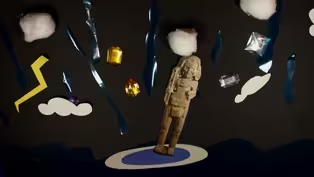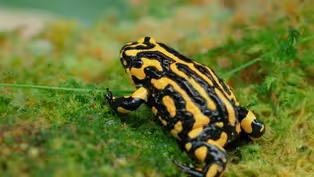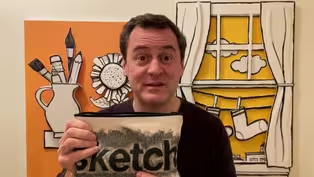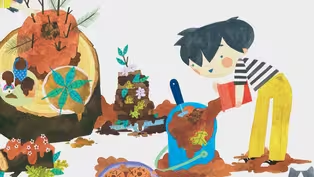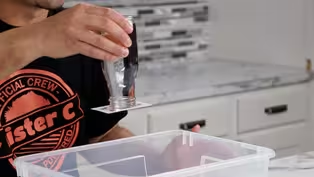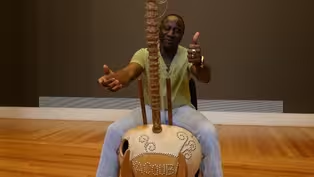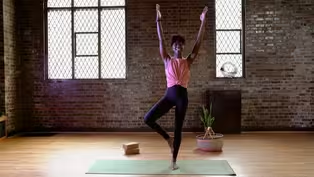
Rain Day
6/30/2023 | 27m 2sVideo has Closed Captions
Make a rain stick, meet a corroboree frog, practice a yoga tree pose.
Make a rain stick, meet a corroboree frog, practice a yoga tree pose. Welcome to CAMP TV – a half-hour day camp experience in your living room! New head counselor Zing Ashford guides “campers” as they learn through play. Content partners include Carnegie Hall, Guggenheim Museum, The Met Museum, Mister C, Blackspace, Story Pirates, San Diego Zoo, WNIN.
Problems playing video? | Closed Captioning Feedback
Problems playing video? | Closed Captioning Feedback
Camp TV is a local public television program presented by THIRTEEN PBS

Rain Day
6/30/2023 | 27m 2sVideo has Closed Captions
Make a rain stick, meet a corroboree frog, practice a yoga tree pose. Welcome to CAMP TV – a half-hour day camp experience in your living room! New head counselor Zing Ashford guides “campers” as they learn through play. Content partners include Carnegie Hall, Guggenheim Museum, The Met Museum, Mister C, Blackspace, Story Pirates, San Diego Zoo, WNIN.
Problems playing video? | Closed Captioning Feedback
How to Watch Camp TV
Camp TV is available to stream on pbs.org and the free PBS App, available on iPhone, Apple TV, Android TV, Android smartphones, Amazon Fire TV, Amazon Fire Tablet, Roku, Samsung Smart TV, and Vizio.
Providing Support for PBS.org
Learn Moreabout PBS online sponsorship♪♪ -Major funding for "Camp TV" was made possible by the New York State Education Department and the JPB Foundation.
Additional funding was provided by the New York City Council.
-♪ "Camp TV" ♪ ♪ It's time for us to start ♪ ♪ From furry animal encounters ♪ ♪ To some reading and the arts ♪ ♪ No matter what the weather, we'll explore it all together ♪ ♪ It's a place for you and me ♪ ♪ It's "Camp TV" ♪ -Hi, campers.
Check it out.
Seems we've got a rain day on our hands, but the rain's not falling very hard.
I don't see any lightning, hear any thunder.
It's not too windy.
And it's definitely not cold.
I wonder, do we really need to stay inside all day?
I mean, what's wrong with getting a little wet, especially if you're properly dressed for the occasion?
Hmm.
Are you thinking what I'm thinking?
I say, rain, rain, don't go away.
Let's head outside for some fun anyway.
♪♪ Okay, all geared up.
Oh, and campers, before you head out, make sure you check with a trusted adult first.
Even better, have them join you.
Ahh.
I just love the way it smells when it rains.
And now for a few of my favorite things to do in the rain -- dancing, catching raindrops on my tongue.
That's one.
That's two!
Ooh, that one tickled my nose.
And looking for rainbows.
[ Gasps ] Oh, there's one.
[ Thunder rumbles ] Whoa!
Time to take cover.
But let me be the first to say welcome to Rain Day on "Camp TV."
Enjoy your first few activities.
Whoa.
Arts and crafts?
Yes, please.
Let's Get Artsy.
♪♪ ♪♪ ♪♪ ♪♪ ♪♪ ♪♪ ♪♪ -You took the words right out of my mouth.
Write On!
-Some stories don't just have one main character... -They have two!
-And in a comedy story, we call this pair a comedy duo.
-They can be best friends, work partners or even strangers.
-But most importantly, this pair needs to be as different as can be.
-But, Sherry, putting very different characters together could cause funny frustrations and silly misunderstandings, which sounds... like a lot of fun.
-Exactly.
The more different they are, the funnier they are together.
And in fact, we don't want them just to be different.
We want them to be complete opposites.
So to create our comedy duo, we could start by imagining what they look like, choosing one detail for one of the characters, and then trying to come up with an opposite detail for the other character.
We could think about what types of characters they are, what they might wear, their hair color, their sizes, anything.
-This one's a woodchuck.
-That one's a park ranger.
-Oh, she has short, spiky fur.
-He has long, flowing hair.
-Oh, she's all gray.
-He has so many bright colors.
And when we're drawing our characters, we could even show the differences in the shapes we use.
One character could be made out of rectangles and squares and lots of angles, and the other character could be made out of very soft, round shapes.
But the most important difference about our duo should be their personality traits.
Personality means what they act like, and we could get a lot of comedy out of two characters behaving in completely opposite ways.
Examples of personality opposites are... -Fearless!
-Nervous.
-Graceful.
-Clumsy.
Whoa!
[ Clattering ] -Grumpy!
-Friendly.
And we could really show off these personality differences during the story when our characters come together to try to solve a shared problem.
-Like what if there were a potato chip twister heading towards the forest?
I bet Tronk the Grumpy Woodchuck wouldn't want to save anybody but herself.
-Really?
Because I bet Bubs, the Friendly Park Ranger would try to save Tronk, and I bet he would also try to make friends with the twister.
You know, just trying to stop it.
-Can these two even solve this problem together?
-Well, figuring that out is what's fun about a comedy duo.
Now it's your turn.
Design your own comedy duo, making them as complete opposites as possible.
Then you could write your own story about the two of them trying to solve one problem together.
We'll see you next time.
Bye!
-Curiosity and wonder.
Let's discover together.
Science Wow!
-Air is stacked all around us and creates 14.7 pounds of pressure per square inch.
But can air really keep water from falling out of this container?
Fill up a glass or a container with some water.
Find a piece of paper, index card or a playing card that completely covers the opening of your container.
Make sure you have something to catch the water just in case it spills.
The card is in place, and now hold it as you turn over the container.
Be brave.
Let go!
And the water stays inside the container.
Gravity is pulling down on the water and creates an airtight seal which doesn't allow air to enter the container.
The pressure outside of the cup is greater than the pressure on the inside of the cup, and this holds the card in place and prevents the water from spilling out.
Give it a try and remember, until next time, keep learning.
Full steam ahead.
-Take a breath.
Take a moment.
It's time for Mindful Me.
Hi, friends.
It's Ms. B. I'm so excited to move with you today.
We're going to learn how to do tree pose.
Tree pose helps us find our balance and it also helps us stay calm.
Are you ready?
Okay.
Starting with our right foot, I'm going to make my right leg nice and strong like a tree trunk.
From here, I'll take my left foot and I'll bring it to the inside.
Okay?
Just so you know, if we move our foot, it's okay to stay at the ankle.
We can stay at our shin.
We can even come all the way up here to our thigh, but never, never, never put your foot on your knees.
We want to make sure that we keep our knees nice and safe.
Okay, so let's try it together.
Really, really, really make that right leg nice and strong.
Imagine it being like a tree trunk, okay?
From here, bring your left foot to the inside.
Remember, you have choices.
I'm going to start with my ankle first today.
Once you place your foot where you want, either at your ankle, at your shin or at your thigh, bring your hands to your hips.
You can stay here or send those fingertips up towards the sky like branches.
And we'll hold it.
And it's okay if you sway a little bit.
Sometimes it gets windy when you're a tree.
Just re-find your balance.
Maybe it means you need to move your foot down.
Try anything you need to, and if you fall over, that's okay too.
Sometimes that just happens.
Okay, so we'll be here being really, really strong with our right leg and we're going to take two breaths together.
In through the nose.
[ Inhaling deeply ] And let it all go.
[ Exhaling deeply ] One more time, in through the nose.
[ Inhaling deeply ] Let it all go.
[ Exhaling deeply ] Rain those branches and fingertips back by your side.
And now we're going to do our left leg.
Plant your left leg just as strong as you did the right, just like a tree trunk.
Make sure it's really, really, really, really strong.
Then take your right foot, bring it to the inside.
Remember, you can stay at your ankle.
You can come to your shin or your thigh.
I'm going to show you what it looks like to come to your shin.
Sliding my foot.
That means I have to really, really keep my tree trunk strong and stand nice and nice and tall and keep my thoughts focused and calm.
Move your hands to your hips for your superhero, or you can send those fingertips up towards the sky.
Bring your arms up like branches.
It's okay if you sway.
It's windy for me too.
And we'll be here and we're going to take two breaths together, okay?
In through your nose.
[ Inhaling deeply ] Let it all go.
[ Exhaling deeply ] In through your nose.
[ Inhaling deeply ] Let it all go.
[ Exhaling deeply ] Rain those fingertips and our arms back by our side, placing our right foot back on the earth.
You did so amazing.
Even if the wind blew you over like it did me, it was still perfect.
I can't wait to move with you next time.
Until then, bye, friends.
-Welcome back to Rain Day on "Camp TV."
Do you love the sound of rain as much as I do?
The pitter-patter on the roof, the ping-ting of it off the windows, the tip-tap of it off the ground.
And if you listen closely, each rainfall has its own unique rhythm to it.
To me, it sounds like music.
Speaking of which, have you ever heard of a rainstick?
A rainstick is a traditional percussion instrument that when you shake it... [ Kernels shaking ] or turn it upside down... [ Kernels shaking ] it sounds like rain.
It was used long ago by certain cultures who believed that when they played it, it could help bring about rainstorms, rainstorms that would provide water to help food and plants grow.
Some traditional rainsticks were made from dead cactus tubes with cactus spines hammered to the inside and filled with tiny pebbles.
In other parts of the world, rainsticks were made from reeds and bamboo.
Today, I thought we'd create our own "Camp TV" rainsticks made out of a few simple items you can find at home.
You will need a cardboard tube -- something like the inside of a paper towel roll or the inside of some food wrap -- some small, dried beans, unpopped popcorn or dry rice, some aluminum foil, a wooden mixing spoon, some tape, and markers to decorate the outside of your rainstick.
To begin, put some tape on one end of the tube to cover it.
This will prevent things from falling out as you put your rain-making things inside.
Next, take a piece of aluminum foil and twist it around the handle of the mixing spoon until you create something that looks like a giant spring.
♪♪ Put it inside the tube, then pour the beans or whatever items you have inside the tube, too.
Whoa.
Making a mess here.
[ Laughs ] Cover the other end of your rainstick with tape and seal it off.
♪♪ And finally, decorate the outside any way you'd like.
♪♪ Perfect.
♪♪ And roll, roll, roll.
♪♪ Okay, time to test it out.
Ready, steady... flip.
[ Kernels shaking ] Ooh.
I like it.
Sounds a lot like rain, if you ask me.
[ Kernels shaking ] [ Thunderclap ] Whoa!
A little birdie told me it's time to Go Wild.
♪♪ [ Rustling ] -In the wild, animals use bright colors as a warning sign to potential predators.
-In most cases, colors like these mean "back off, I'm poisonous."
And in this case, it's 100% accurate.
You're looking at a Corroboree frog.
This species secretes a toxic substance from its skin which would make it very unappetizing as a snack.
Quite a handy defense mechanism to have, though.
But unfortunately for the Corroboree frog, this species is in trouble.
So Corroboree frogs are critically endangered.
They're actually one of Australia's most critically endangered species.
-They are native to the Snowy Mountain ranges of New South Wales, where much of the habitat is protected by national parks, and they're poisonous to eat.
So what is the cause of their decline?
Well, they suffer from a disease known as chytrid fungus, which is unfortunately affecting amphibians worldwide.
-Basically what happens is the fungus will cover the skin where there's any keratin.
Now, considering that frogs will breathe through their skin, it makes it very difficult for them to then breathe.
-It also can affect their nervous system as well.
-So the keepers at Taronga Zoo are doing everything they can to help these beautiful Aussie natives out by running a very successful breeding program.
-Taronga is heavily involved in breeding and releasing Corroboree frogs back into the wild.
As part of the National Recovery Program, we have released hundreds of frogs and thousands of eggs as well back into Mount Kosciuszko.
-It's not easy to successfully breed that many frogs.
It takes a lot of dedication and hard work from the keepers every day.
They know exactly which frog is which by photographing them and keeping records.
And each frog is sorted into a group based on which stage it's at in its life cycle.
The keepers also need to keep the room at the correct temperature to make sure the frogs are comfortable, and males and females are kept separate until it's time for breeding.
It's a big job, but it's worth it.
-They are one of the most iconic Australian species that we do have here.
-They play a very important part of the alpine ecosystem.
Even as teeny, tiny little tadpoles, they actually eat all of the algae in all the ponds, which means it's crystal clear for all of the other animals and plant life there too.
-So it's thanks to breeding programs like this one that Corroboree frogs are given a fighting chance in the wild.
-Music, dance, magic and more.
Step right up to Center Stage.
♪♪ ♪ Ah, lai lai ko lo ♪ ♪ Si-ko lai ko ♪ ♪ Wa-wan-ko ♪ ♪ Si-ko lai ko ♪ I ni ce, Musical Explorers.
My name is Yacouba, and I'm going to teach you how to sing this beautiful song.
It's called "Wa-Wan-Ko," which mean "friendship," to be friends forever.
I will teach you the lyrics.
Very, very simple.
You're going to repeat after me.
Wa-wan-ko.
Si-ko lai ko.
Again.
Wa-wan-ko.
Si-ko lai ko.
Beautiful.
Okay, now, we're going to sing the melody together.
Just repeat after me.
It's simple.
♪♪ ♪ Wa-wan-ko ♪ ♪ Si-ko lai ko ♪ You.
Again.
♪ Wa-wan-ko ♪ ♪ Si-ko lai ko ♪ Uh-huh!
♪♪ ♪ Wa-wan-ko ♪ ♪ Si-ko lai ko ♪ You.
♪ Wa-wan-ko ♪ ♪ Si-ko lai ko ♪ Uh-huh!
♪♪ Beautiful.
-Arts and crafts?
Yes, please.
Let's Get Artsy.
-I'm really excited to see you.
Today, I'm thinking about art materials.
I love art materials.
I love colored pencils.
I love markers.
I love other markers.
I love pencil sharpeners.
I love pencils.
I love erasers.
I love paint.
I love anything you can use to make a work of art.
Whenever I open up my bag full of materials, well, it feels like a party.
I want to try something that I've never tried before.
I want to make a work of art using some very unusual materials.
Come to my drawing board.
Let me show you what I mean.
Come on.
So I have these beautiful roses in my home, and I was thinking, what if I were to use these roses as an unusual drawing material?
So here's my idea.
I'm going to draw a picture of one of the roses while using another rose as my drawing tool.
I'm going to use the bottom part, the stem as my drawing tool.
I'm going to dip it into black paint and draw what I see.
So I'm drawing the leaves at the bottom of the the rose petals first and drawing the stem.
I'm noticing right away that I have to keep dipping the rose stem into the paint.
It doesn't hold a lot of paint, so I have to keep returning to my paint and dipping it in, but it makes these beautiful marks.
They go from dark to light.
There's a little bit of texture to them, and I can actually make some of the marks thin and some of the marks thick.
I'm looking closely at the shape of the petals and just moving my drawing tool around to try to capture the shapes that I see in the rose.
It actually allows me to do a little bit of shading.
I can get some paint on the end of the rose stem and just drag it across the paper, and I get some dark marks.
Really nice way to shade and get texture.
I love the mark-making and the way it looks.
Now, here's my next idea.
I want to add some color, so I was thinking, well, what else could I use for color that would be unexpected?
And I came up with the idea of painting with tea.
I have this lemon flavored tea, and even though it's lemon, it actually makes this beautiful, pinkish-reddish color in my cup.
So here I am.
I'm going to paint this rose that I drew with a rose and I'm going to paint it with tea.
I'm adding some layers of the lemon-flavored tea onto my drawing and noticing that it's very light, so I need to add 2 or 3 layers to build up the darks and lights in the rose, but it's actually quite lovely.
It's a really beautiful color that I'm getting from the tea.
I want to add some green too, and I want to keep this theme of using unexpected materials going.
So here's my next idea.
I'm coloring onto my drawing using the actual leaves from the rose.
If I push down into the paper with the leaf, it leaves some of the green pigment onto the paper.
So now I have this finished drawing of a rose that I created with a rose.
I colored it with tea and the color that came off of the actual rose leaves.
This was such a fun experiment in drawing with unexpected materials.
I've never drawn with a rose stem before, and painting with the tea actually felt a lot like painting with watercolor.
In the end, I have a really nice drawing and had a great experience.
Creating this image of the rose has reminded me of one of my favorite drawings from the Guggenheim Museum, this drawing of a flower.
It's a chrysanthemum, and I keep thinking, "Wow, there are so many different ways to make drawings."
You could use charcoal or traditional materials like this drawing or ink and a rose stem like the one that we used.
My challenge for you this week is, you guessed it, make a work of art using an unexpected drawing material.
You can use the end of a flower like I did, or maybe you could use a stick, or you could take a sponge and dip it into paint and make some marks.
Or you could even use your fingers.
Just make sure you clean up afterwards.
It was so much fun to make a drawing with a flower.
-Daytime or nighttime, it's always time for story time.
Ready for just the right book read by just the right camper?
Without further ado, take it away.
-Thanks, Zing.
Hi, my name is Rachel, and today I will be reading "Mud" by Annie Bailey, Illustrated by Jen Corace.
"Gloopy, gloppy, gorgeous mud, oozy, smoozy, soupy mud.
Stomp it, poke it, squeeze it, whack it, pack it into bricks and stack it.
Heave it high and watch it splat.
Throw it at your sleeping cat?
No, no, not the cat!
Never, EVER at the cat.
Meow!
Serve the specials of the day in your mucky mud café.
Pies and donuts, squishy stew.
Decorate a cake or two.
Just make sure you never chew it.
You'll regret it if you do it.
Blech!
When you tire of your cooking and you're sure that no one's looking... Whoosh!
Smash!
Ack!
Bash!
Fwump!
Clash!
Yikes!
Crash!
Little sis has perfect aim?!
Time to play a different game.
Paint a portrait of your cat.
Sculpt a hairdo or a hat.
Dig a murky, marshy lake.
Slither through it like a snake.
Make an angel, slip and slide, jump and roll and swim and glide.
"Dinner's ready.
Come and get it!
Hurry, kiddos!
Ee!
Wait a minute!"
Mother jumps behind the screen.
"Don't come in until you're clean!"
Grab the hose and let it fly.
Water diamonds in the sky.
Blurble, squirble, blop and glop.
Squilchy squelchy, shlop and flop.
Scrub-a-dub, all clean again.
Time to go inside, but then... Drip drop, splish splosh, squish squash.
Squishhh, squashhh.
Muuuuuuud!
The end."
I hope you enjoyed reading with me.
Bye!
♪♪ -♪ "Camp TV" ♪ ♪ It's time for us to part ♪ ♪ From furry animal encounters ♪ ♪ To summer reading and the arts ♪ ♪ No matter what the weather, we'll explore it all together ♪ ♪ It's a place for you and me ♪ ♪ It's "Camp TV" ♪ -Major funding for "Camp TV" was made possible by the New York State Education Department and the JPB Foundation.
Additional funding was provided by the New York City Council.
Content provided by the following... ♪♪ ♪♪ ♪♪ ♪♪ ♪♪ ♪♪
Animation Inspired by a Maya Deity and Rain
Video has Closed Captions
Clip: 6/30/2023 | 43s | Enjoy a weather-themed stop-motion animation from The Met Museum. (43s)
Video has Closed Captions
Clip: 6/30/2023 | 2m 36s | Learn about the endangered corroboree frog with San Diego Zoo Wildlilfe Explorers. (2m 36s)
Making Art with Unusual Materials
Video has Closed Captions
Clip: 6/30/2023 | 4m 33s | At the Guggenheim Museum, Jeff makes a picture using roses stems, rose leaves, and tea! (4m 33s)
Video has Closed Captions
Clip: 6/30/2023 | 2m 4s | From WNIN, Rachel reads “MUD!” by Annie Bailey, illustrated by Jen Corace. (2m 4s)
Story Pirates University: Comedy Duos
Video has Closed Captions
Clip: 6/30/2023 | 3m 6s | From Story Pirates, discover what character elements can help you make a great comedy duo! (3m 6s)
Video has Closed Captions
Clip: 6/30/2023 | 51s | Can air keep water from falling out of an upside-down container? Mister C shows us how! (51s)
Video has Closed Captions
Clip: 6/30/2023 | 2m 1s | Sing and move along to “Wawanko” with musician Yacouba from Carnegie Hall! (2m 1s)
Video has Closed Captions
Clip: 6/30/2023 | 3m 26s | From Blackspace, practice tree pose with Miss B! (3m 26s)
Providing Support for PBS.org
Learn Moreabout PBS online sponsorshipSupport for PBS provided by:
Camp TV is a local public television program presented by THIRTEEN PBS
